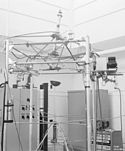Godiva-before-scrammed
The Lady Godiva device in the scrammed state. An unreflected 54Kg sphere of 93.7% pure 235U.
References
- review of criticality accidents - 2000 revision (pdf). Los Alamos Scientific Laboratory (2000-05). Retrieved on 2008-02-29.

|
This image comes from Los Alamos National Laboratory, a national laboratory privately operated under contract from the United States Department of Energy by Los Alamos National Security, LLC between October 1, 2007 and October 31, 2018. LANL allowed anyone to use it for any purpose, provided that the copyright holder is properly attributed. Redistribution, derivative work, commercial use, and all other use is permitted. LANL requires the following text be used when crediting images to it: (link)
Unless otherwise indicated, this information has been authored by an employee or employees of the Los Alamos National Security, LLC (LANS), operator of the Los Alamos National Laboratory under Contract No. DE-AC52-06NA25396 with the U.S. Department of Energy. The U.S. Government has rights to use, reproduce, and distribute this information. The public may copy and use this information without charge, provided that this Notice and any statement of authorship are reproduced on all copies. Neither the Government nor LANS makes any warranty, express or implied, or assumes any liability or responsibility for the use of this information. |

|
Relevante Bilder
Relevante Artikel
Godiva-ReaktorDer Godiva-Apparat war ein nicht abgeschirmter, gepulster Forschungsreaktor, der im Los Alamos National Laboratory (LANL) in New Mexico vom April 1952 bis Februar 1957 in Betrieb war. Er wurde in der technischen Abteilung 18 (TA-18) verwendet und zur Erzeugung von kontrollierten Gamma- und Neutronenstrahlungspulsen genutzt. Bestrahlt wurden Testobjekte zwecks Untersuchung der Materialien unter Strahlenbelastung. .. weiterlesen

